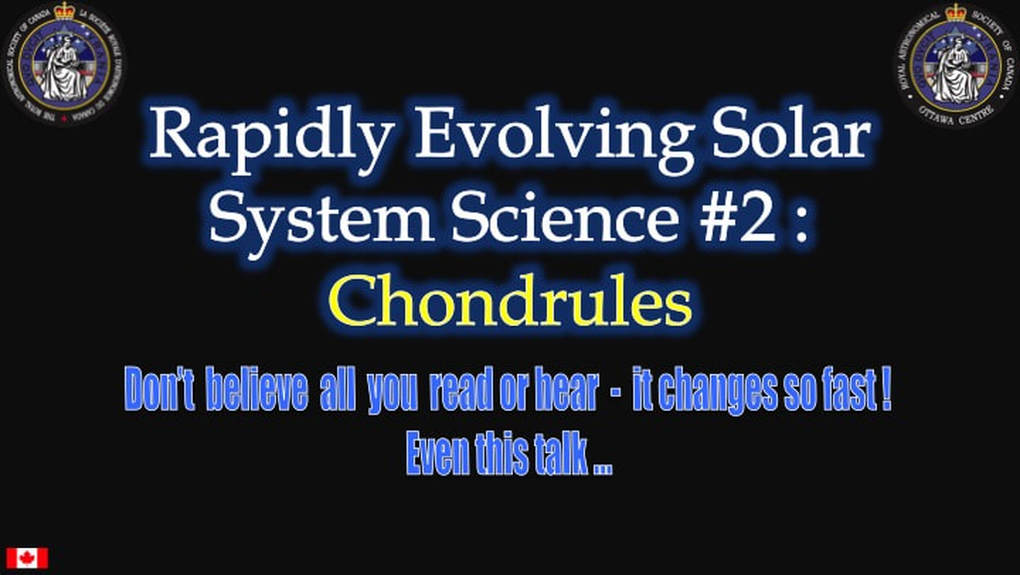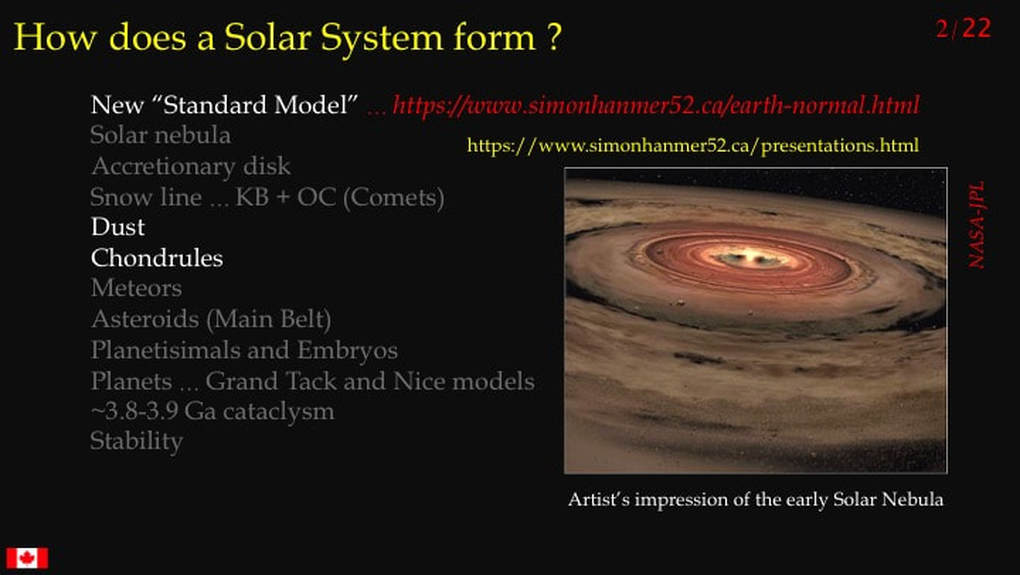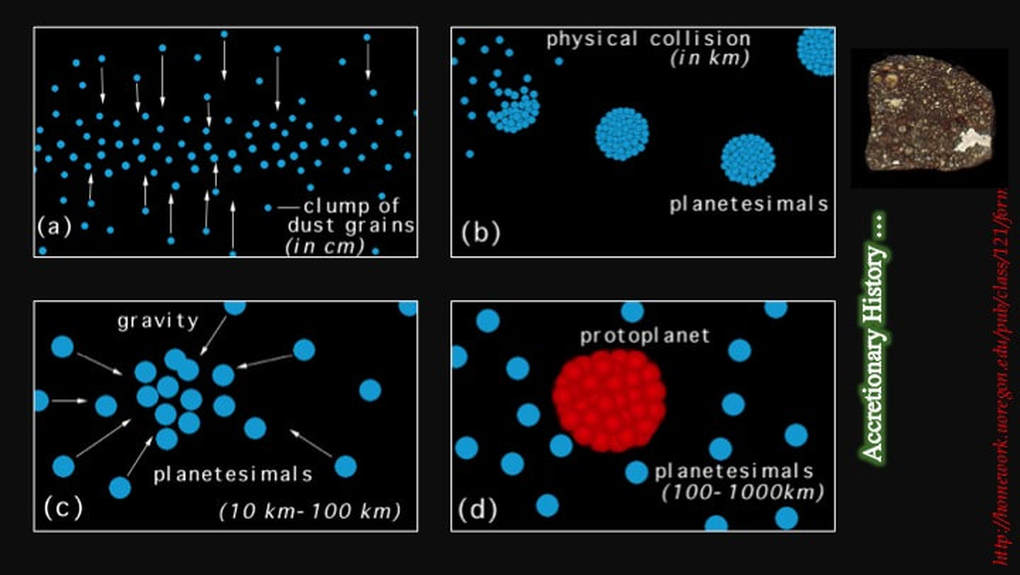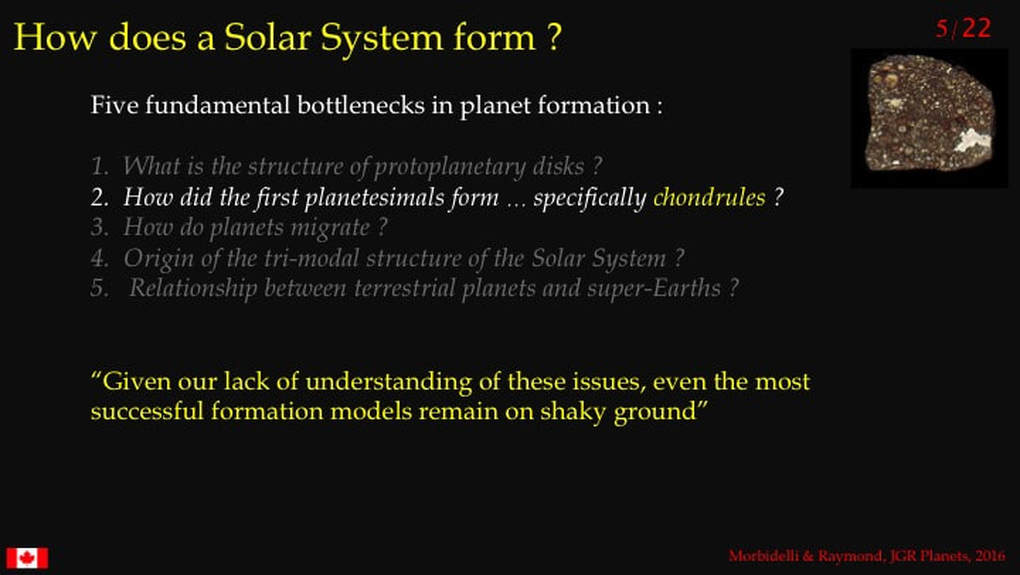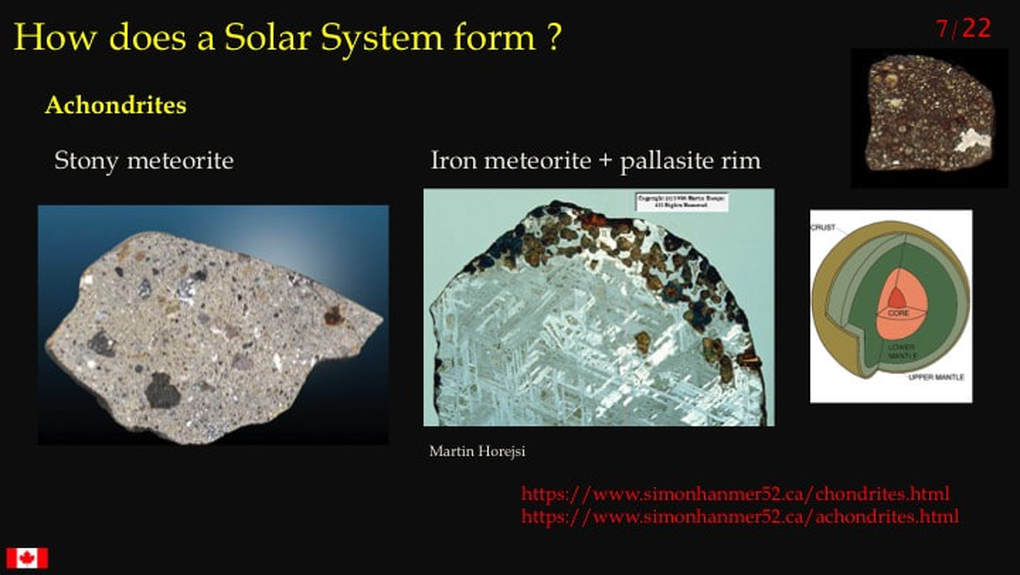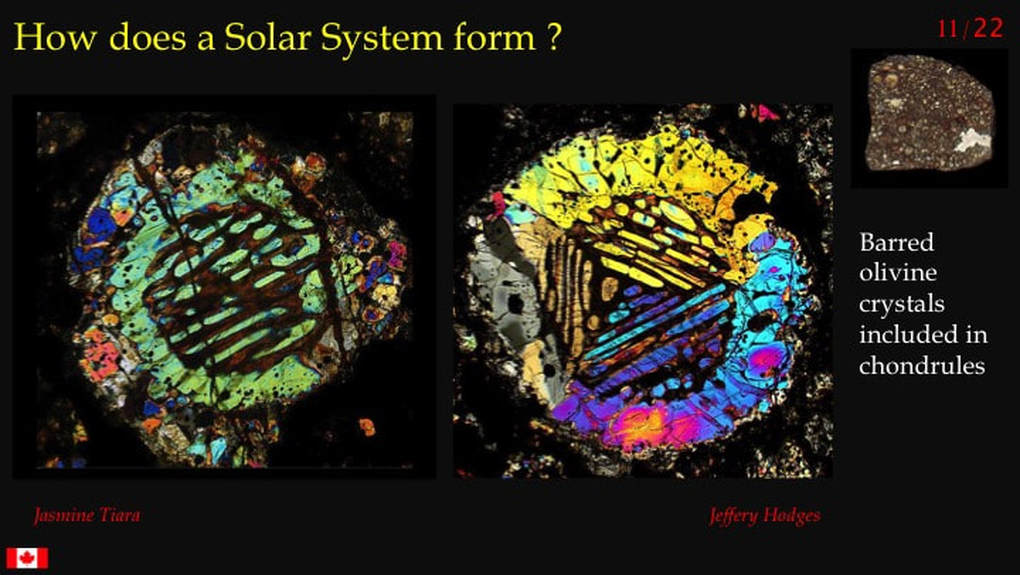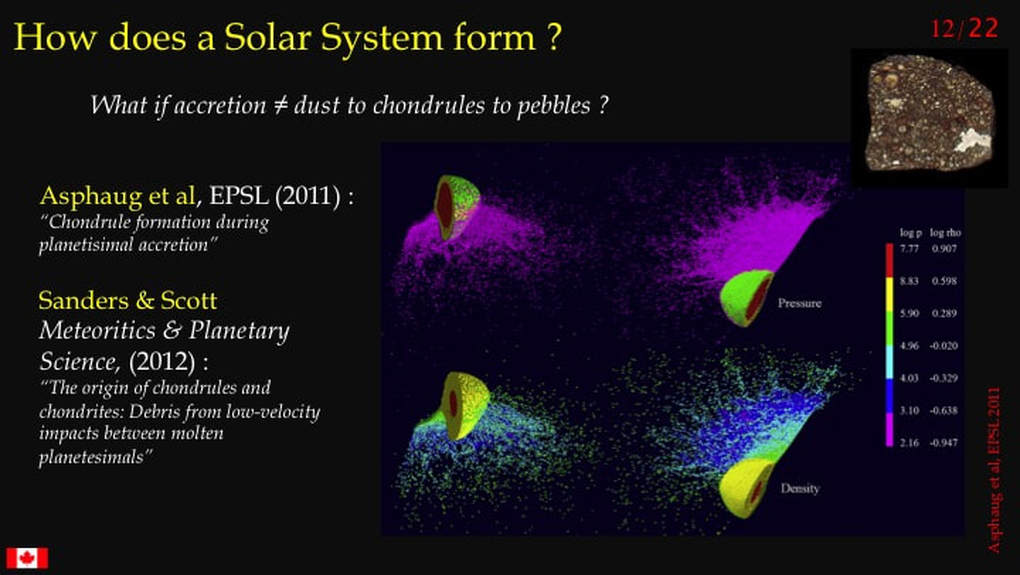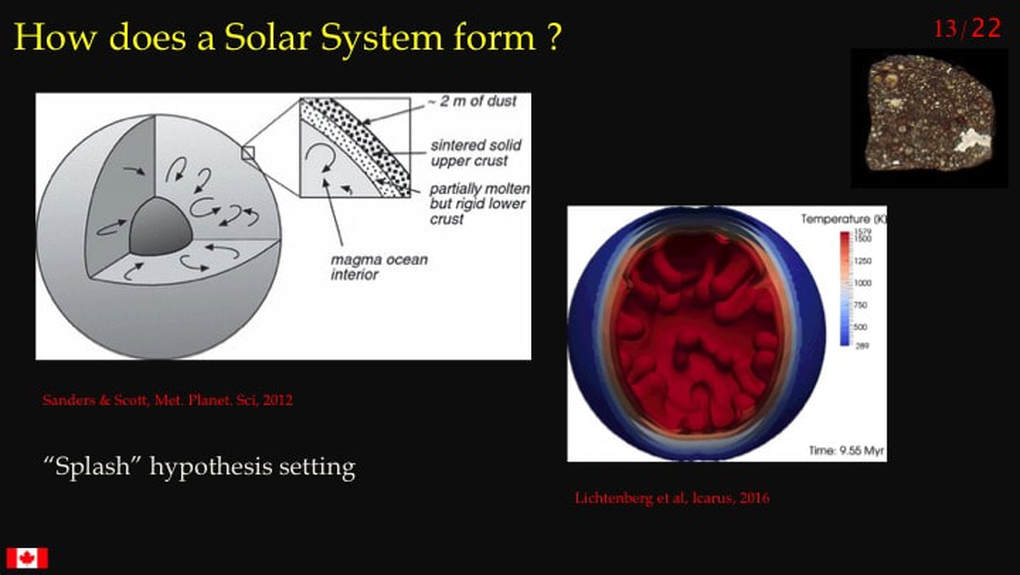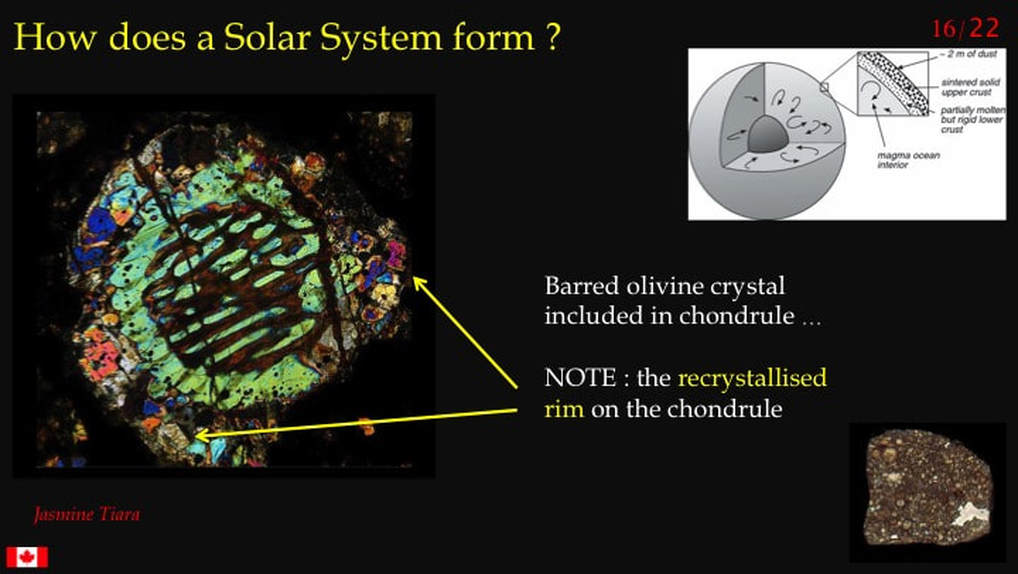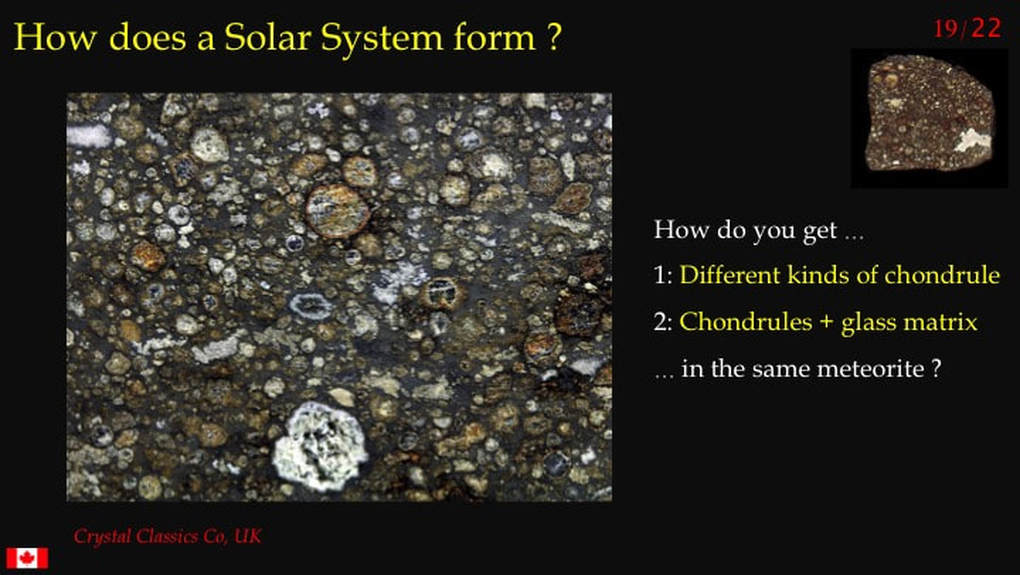|
RAPIDLY EVOLVING SOLAR SYSTEM SCIENCE
|
My first presentation in this series on Rapidly Evolving Solar System Science was entitled “Origins” https://www.simonhanmer52.ca/solar-system--origins.html. It contained three parts.
First, I presented an overview of what has become the “new standard” model for the origins of the planetary component of our Solar System - from the solar nebula to planetary accretion and the eventual migration of the Giant Planets - and pointed out some of its major weaknesses ; one of which is the difficulty of explaining the time-gap between the first 100 Ma after the formation of the Sun and the supposed Late Heavy Bombardment some 600 Ma later. Second, a key, integral part of that model is the initial accretion of primordial dust to form the first grains of rocky material, and I highlighted how poorly we understand how nature overcame the multiple barriers to accretionary growth beyond the size of dust and sand grains. Some scientists believe that turbulence in the primordial accretionary disk helped overcome some of these barriers to early accretion, which brought us to the third part of the talk : the behaviour of gas, dust and solid particles in the accretionary disk and how the disk’s behaviour may have been governed by its viscosity. However, I pointed out that we have no way of knowing how that viscosity was distributed in space or how it evolved with time – which means that large-scale models of accretionary disk behaviour and structure are dramatically over-simplified, and there’s nothing we can do about it ! Here, I want to return to the issue of accretion from dust to planets.
You’ll recall that the classical model of Solar System formation states that somehow dust turned into gravel-sized chondrules of rocky material, that clumped together to form pebble-size objects, that further clumped together to form asteroids, planetisimals, planetary embryos, and eventually planets.
The operative word here is “somehow”, because there’s a great deal of debate about this – especially regarding the formation and significance of chondrules – and that’s what we’re going to look at here. Here’s the spoiler : today this accretionary time sequence from dust to chondrules to planetary bodies appears to be wrong, and we’re going to look at why.
In my first presentation of this series I showed this list of the five fundamental “headaches” confronting professional planetary scientists trying to understand Solar System formation. Here, we’re going to go back to number two - but with a slight change in wording : How did chondrules form ? The formation of chondrules is one of the fundamental questions regarding planet formation. If we don’t understand how chondrules form, we can’t work out how planets - and the entire Solar System - formed. According to the classical view of chondrule formation, dust in an accretionary disk sticks to other dust by electrostatic forces, and ends up forming dust bunnies that get flash-melted by some form of energetic shock – such as solar storms or electrical discharges in the accretionary disk. According to this view, chondrules were formed before accretion, and therefore represent the fundamental building materials of asteroids and planets.
However, we’ve known for decades that there are major problems with this model, not the least of which is the common presence of well formed crystals of silicate – or rock-forming minerals – as inclusions within individual chondrules, that could not have grown in the gas and dust of the primordial accretionary disk. This image shows a very obvious chondrule with multiple well-formed colourless crystals as inclusions. In order to achieve their size (several mm) and their shapes, the included crystals needed time to grow within a slowly cooling magma before the chondrule formed and included them, and that can only be achieved in a slowly cooling body of magma within an already formed planetary body. In short, chondrules cannot have formed before asteroids and planetisimals. So, if the classical model of chondrule formation by accretion doesn’t explain what we observe in nature, where do we go from here ? First, let’s take an overview of the primary observational evidence, and then let’s look at what the professional astrophysicists are up to : computer modelling !
Let’s start with meteorites …
Let’s start with meteorites …
Meteorites can be classified according to two schemes. The simple scheme talks about chondrites or chondritic meteorites, plus stony and iron meteorites (the achondrites). As I told you in a pair of talks 15 years ago (https://www.simonhanmer52.ca/chondrites.html and https://www.simonhanmer52.ca/achondrites.html, chondrites represent the most primitive meteorites whose chemical composition corresponds to that of the original solar nebula (minus H and He). On the other hand, the achondrites – essentially stony and iron meteorites - represent the rocky crusts and the Fe-Ni cores of planetary bodies that melted, differentiated and then broke up during asteroidal collisions. Curiously there aren’t many examples known of meteorites that represent the volumetrically dominant mantle rocks of differentiated planetoids, but that’s another story. The more complicated scheme divides meteorites into groups, principally classified according to their chemical and mineral composition. There are between 100 and 150 such groups – depending on who you talk to – and each group represents a different parent body that shattered during a collision : most commonly a collision that occurred early in the Solar System’s history. Here’s the important part : on the one hand, only about 1/5 of the parent bodies is chondritic, i.e. primitive, the rest, 4/5 of parent bodies, melted – thanks to the accumulation of heat from radioactive elements contained within them - and differentiated. This means that the vast majority of early planetoids were internally hot. This is going to be very important in just a minute, so keep it in mind. On the other hand, chondrites account for 5/6 of the number of meteorites (as distinct from groups), which means that the formation of chondrules was a process that affected a substantial fraction of the solid material in the solar nebula. In short, it was an important process that we need to understand.
So, what exactly are chondrules ? They are grains of Mg-rich silicate minerals - [olivine, (Mg,Fe)2 SiO4 and pyroxene, (Mg,Fe)SiO3] - that make up 50% or more by volume of most chondrites. The rest - the matrix that sticks the chondrules together - was originally glass mixed with inorganic carbon. The chondrules formed by the cooling and solidification of droplets of silicate liquid that chilled in space in a matter of hours according to lab experiments. This much appears to be pretty straightforward, except that it does not allow enough time for the well-formed crystal inclusions we just saw two slides back to grow - and droplets of silicate liquid floating in empty space should chill in seconds, not even hours !
So, what exactly are chondrules ? They are grains of Mg-rich silicate minerals - [olivine, (Mg,Fe)2 SiO4 and pyroxene, (Mg,Fe)SiO3] - that make up 50% or more by volume of most chondrites. The rest - the matrix that sticks the chondrules together - was originally glass mixed with inorganic carbon. The chondrules formed by the cooling and solidification of droplets of silicate liquid that chilled in space in a matter of hours according to lab experiments. This much appears to be pretty straightforward, except that it does not allow enough time for the well-formed crystal inclusions we just saw two slides back to grow - and droplets of silicate liquid floating in empty space should chill in seconds, not even hours !
Classical theory says that clumps of dust in the solar nebula were transformed directly to chondrules by rapid melting, probably as a result of shock-induced heating of some sort. Where did this idea come from ? First, because of the remarkable similarity between the chemical composition of chondrites and that of the Sun’s photosphere, except for gases (e.g., H, He, C, N, Ar) - and since the Sun’s composition is the same as that of the primordial solar nebula, chondrules are supposed to be primitive.
Second, because calcium-aluminium inclusions (CAIs) occur as inclusions both in chondrules and in the matrix of chondrites. This was considered to be important because, by convention, CAIs are taken to mark the beginning of time in the Solar System (t=0) and were interpreted to form in the same way as chondrules, but just prior to them.
According to this model, after initial accretion, some chondritic planetesimals became overheated, melted, and differentiated into metal cores and basaltic crusts, the sources of iron and stony meteorites (the achondrites). However, as we’ve already seen with the well formed crystal inclusions within chondrules, this entire story has now been called into question.
In addition, there are now major issues with finding a heat source for flash melting dust clumps in space. Many heat source models have been proposed based on solar wind, electrical discharge heating, electromagnetic radiative heating, gamma-ray bursts and heating in protostellar jets, but they all seem to have insurmountable problems. The currently favored nebular shock-melting model (2002-2012) invokes bow shocks around planetary embryos ploughing their way through the gas and dust of the accretionary disk, but it doesn’t explain the physical diversity of different chondrules. However, if chondrules formed via processes involving already formed planetesimals, then we would have to see them as a ‘by-product’ of planet(esimal) formation, rather than a precursor. and this is a completely different ball game !
So let’s now look at this new ball game ; a game that the professional astrophysicists are currently playing by computer modeling because there’s no other way to do it ! Back in 1980, a new hypothesis suggested that many chondrules are in fact frozen droplets of spray from impact plumes launched when thin-shelled, hot, largely molten planetesimals collided during accretion. Referred to as the ‘‘splash” hypothesis, it was not taken seriously until computer simulations in 2011 showed that it was possible - at least theoretically. The key to understanding the modern version of this model is the role of the radioactive elements responsible for heating the early planetisimals : specifically Al26, which has a very short half-life of only 0.7 Ma as it radioactively decays to Mg26 and generates heat. This means that the early planetoids were only heated internally by Al26 during a short time window of ~2-5 Ma, with a maximum heating and melting window at ~1.5 Myr after CAI formation. So, according to the “splash” model, the chondrite meteorites we find today do not come from collisional break-up of the earliest planetesimals – as the classical model states – because the early accreted chondrules would have been destroyed as those early planetoids were heated by Al26, melted and differentiated. Instead, chondrite meteorites are made of material that accreted later, when Al26 had radioactively decayed to the point that it could no longer induce the melting of planetoids.
Just how exactly does this “splash” model of chondrule formation work – at least in the computer simulations ? Imagine a young solar nebula heated by Al26. Most of the material existed as molten, or partially molten, planetesimals for the first ~2.0 Myr after CAI formation. These largely molten spheres of primitive magma were undergoing turbulent convection in internal magma oceans, each enclosed by a thin outer shell of rigid crust.
Collisions between planetisimals would have launched huge plumes of molten droplets (spray) from the internal magma oceans, mixed with loose material from the planetesimal surfaces. Most collisions would have been oblique glancing blows in which much of the smaller body (the projectile) would have been engulfed by the larger body (the target), while the ‘‘overshooting’’ portion would have undergone catastrophic decompression and expanded slowly down-stream as a huge fan-shaped plume of melt droplets and debris in nebular space - where the droplets would chill / quench to form chondrules.
Why are astrophysicists so keen on hot / molten planetisimals ? Think about it : in order to melt something you need energy to transform into heat for the melting to occur. In the early Solar System, the obvious energy source is the kinetic energy of motion during asteroidal collisions. However, the colder the starting temperature, the more energy à heat you need, which in turn requires high speed collisions to provide all that energy. Equally, the converse is true : a hot planetisimal (heated by Al26) only requires a small collisional energy input in order to melt, which translates into relatively slow collisions between impactors and targets. By introducing slow impact speeds into the model, and ejecting the melts produced by the impacts at speeds that approximate to the asteroidal escape velocities, the spray of molten magma generated by a collision doesn’t go very far from the target asteroid - so, most of the chondrules from the ejected melt spray will quickly fall back onto the surface of the target asteroid, rather than flying off into space. This is a very attractive numerical model for chondrule formation, but does it explain tangible observations that we can make in real samples of meteorites that other models cannot ? Yes ! So, let’s briefly look at four of the simpler ones : we’ll skip the isotopic chemistry here !
First, some chondrules in some meteorites have recrystallized outer rims. According to the low impact velocities of the “splash” model, chondrules would have fallen back onto one or other of the colliding bodies, forming part of the rigid crust that was underlain by a convecting magma ocean. The “splash” model would explain these rims as either the product of remelting and recrystallization of older, accreted chondrules due to the heat of a new, younger impact, or as new rims crystallised on older chondrules that got entrained into the underlying magma ocean prior to being ejected - yet again - during a later impact event.
Second, as we’ve already seen, many chondrules contain perfectly formed coarse crystals of silicate minerals. The “splash” model suggests that the coarse crystals formed within the convecting magma ocean and were subsequently ejected into space with the molten magma during asteroidal collision. In short, when planetisimals meet and collide, they eject a plume that contains older well-formed crystals and fragments of crystals, which end up as inclusions in the droplets of molten rock from the internal magma oceans that form chondrules in the bulk of the plume.
Third, chondrules in some meteorites have mutually indented shapes. They are molded against neighboring chondrules, indicating that they were still hot and plastic, if not liquid, when they came into contact. Sometimes these molded chondrules form clusters indicating that they came together as a group of hot and plastic chondrules that became welded to each other. According to the low impact velocities of the “splash” model, chondrules would have fallen back onto one or other of the colliding bodies, piling up on the surface and getting squished under their own weight while still hot and plastic.
Fourth and last, many chondritic meteorites contain chondrules of many different types and compositions in the same meteorite. The “splash” model explains this as a direct consequence of plumes of mixed materials from multiple, successive chondrule-forming impact events involving multiple different asteroidal bodies. In addition, it offers a neat explanation for the presence of chondrules and chilled / quenched glassy matrix together in a given chondrite meteorite.
There is a fifth issue that the “splash” hypothesis may resolve : why do lab results predict that chondrules took hours to chill, but numerical models predict quenching in seconds ? According to the “splash” hypothesis, the close spacing of the magma droplets in the dense ejected collisional plume provides thermal insulation that slows the cooling rate of the droplets, compared with the cooling rate of an isolated droplet in the cold of open space. Pretty neat in my opinion !
There is a fifth issue that the “splash” hypothesis may resolve : why do lab results predict that chondrules took hours to chill, but numerical models predict quenching in seconds ? According to the “splash” hypothesis, the close spacing of the magma droplets in the dense ejected collisional plume provides thermal insulation that slows the cooling rate of the droplets, compared with the cooling rate of an isolated droplet in the cold of open space. Pretty neat in my opinion !
So far, so good. It seems like we now have a viable model for the creation and accretion of chondrules to make chondritic asteroids and meteorites, or do we ? In 2017, a group of planetary scientists pointed out that if the planetisimals involved in the “splash” model for chondrule formation were molten with interior magma oceans, there are consequences for the chemical and isotopic composition of chondrules - too detailed for us to get into here - that we do not observe. To get around these issues, they suggested that the planetisimals were almost, but not quite, molten : essentially a minor correction to the overall “splash” model for the formation of chondrules and chondrites.
So yes, after all these years we really do seem to have a viable model for the formation of the all important chondrules during the early history of the Solar System. The take-home message of this new “splash” model is that most achondrite meteorites (the irons and stones) now appear to come from planetesimals that had accreted, melted and differentiated extremely early in the Solar System’s history, within only 2 Myr after CAI formation. Once Al26 had decayed such that it could no longer induce the melting of planetoids, chondrules could begin to survive, which means that the chondrite parent asteroids were assembled later than ~2.0 Myr after CAIs. Put simply, chondrites – far from being the first planetoids to have accreted in the Solar System, as is conventionally assumed - were likely among the last !
Proudly powered by Weebly
